ESP Lancia Ypsilon 2011 Owner handbook (in English)
[x] Cancel search | Manufacturer: LANCIA, Model Year: 2011, Model line: Ypsilon, Model: Lancia Ypsilon 2011Pages: 299, PDF Size: 13.35 MB
Page 6 of 299
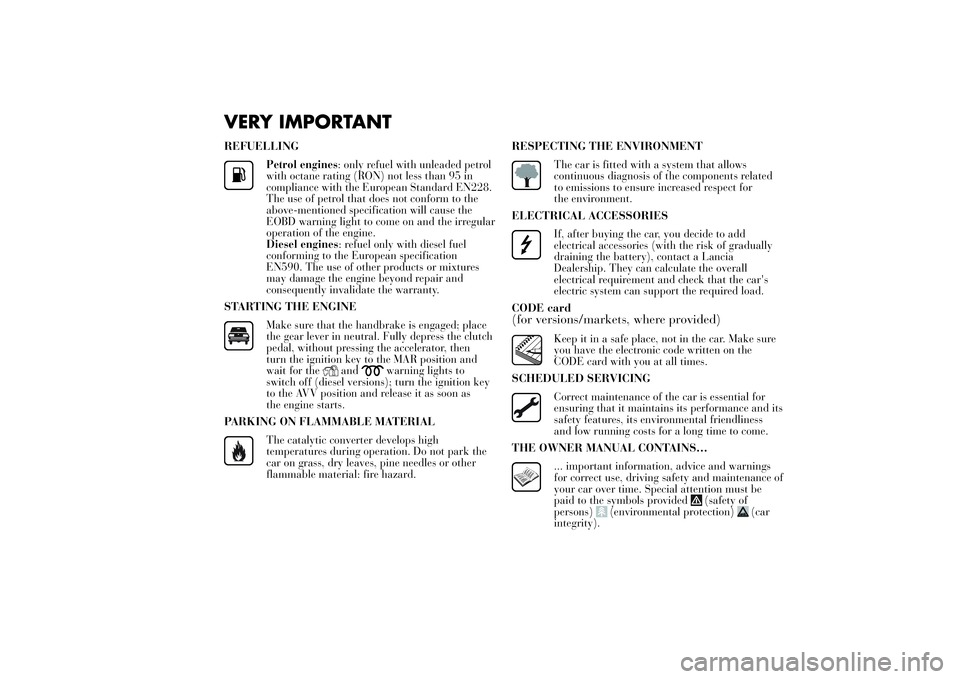
VERY IMPORTANTREFUELLING
Petrol engines: only refuel with unleaded petrol
with octane rating (RON) not less than 95 in
compliance with the European Standard EN228.
The use of petrol that does not conform to the
above-mentioned specification will cause the
EOBD warning light to come on and the irregular
operation of the engine.
Diesel engines: refuel only with diesel fuel
conforming to the European specification
EN590. The use of other products or mixtures
may damage the engine beyond repair and
consequently invalidate the warranty.
STARTING THE ENGINE
Make sure that the handbrake is engaged; place
the gear lever in neutral. Fully depress the clutch
pedal, without pressing the accelerator, then
turn the ignition key to the MAR position and
wait for the
and
warning lights to
switch off (diesel versions); turn the ignition key
to the AVV position and release it as soon as
the engine starts.
PARKING ON FLAMMABLE MATERIAL
The catalytic converter develops high
temperatures during operation. Do not park the
car on grass, dry leaves, pine needles or other
flammable material: fire hazard.
RESPECTING THE ENVIRONMENT
The car is fitted with a system that allows
continuous diagnosis of the components related
to emissions to ensure increased respect for
the environment.
ELECTRICAL ACCESSORIES
If, after buying the car, you decide to add
electrical accessories (with the risk of gradually
draining the battery), contact a Lancia
Dealership. They can calculate the overall
electrical requirement and check that the car's
electric system can support the required load.
CODE card(for versions/markets, where provided)
Keep it in a safe place, not in the car. Make sure
you have the electronic code written on the
CODE card with you at all times.
SCHEDULED SERVICING
Correct maintenance of the car is essential for
ensuring that it maintains its performance and its
safety features, its environmental friendliness
and low running costs for a long time to come.
THE OWNER MANUAL CONTAINS…
... important information, advice and warnings
for correct use, driving safety and maintenance of
your car over time. Special attention must be
paid to the symbols provided
(safety of
persons)
(environmental protection)
(car
integrity).
Page 46 of 299

ACTIVATION OF INTERIOR AIR
RECIRCULATION AND ENABLEMENT OF
AQS FUNCTION (Air Quality System)
Press button
.
Internal air recirculation is carried out according
to three possible operating modes:
❒automatic control;
❒forced deactivation (air recirculation always
deactivated, air taken from the outside)
❒forced activation (internal air circulation always
activated).
When the OFF button is pressed, the climate
control system automatically activates internal air
recirculation. External air recirculation can always
be activated by pressing button
and vice
versa.
With the OFF button pressed, it is not possible to
activate the AQS (Air Quality System) function.IMPORTANT Internal air recirculation makes it
possible to reach the required heating or cooling
conditions more quickly depending on the mode
selected. It is not advisable to switch the air
recirculation on when it is rainy/cold to prevent
the windows from misting, especially if the climate
control system has not been activated. It is
advisable to switch the internal air recirculation
on whilst queuing or in tunnels to prevent the
introduction of polluted air. Do not use the
function for a long time, particularly if there are
several passengers on board, to prevent the
windows from misting.
AQS (Air Quality System) function activation
The AQS function automatically activates internal
air recirculation when the outside air is polluted
(e.g. in traffic queues and tunnels).
IMPORTANT With the AQS function active, after
15 consecutive minutes of the internal air
recirculation system functioning, the climate
control system enables the intake of outside air for
approximately 1 minute to freshen the air in the
passenger compartment. This takes place
regardless of the pollution level of the outside air.
CLIMATE CONTROL COMPRESSOR
ACTIVATION/DEACTIVATION
Press button
to switch on the climate control
compressor.
Compressor activation:
symbol appears on
display.
44GETTING TO
KNOW YOUR CAR
SAFETY
STARTING
AND
DRIVING
WARNING LIGHTS
AND MESSAGES
IN AN EMERGENCY
SERVICING AND
MAINTENANCE
TECHNICAL
SPECIFICATIONS
INDEX
Page 50 of 299
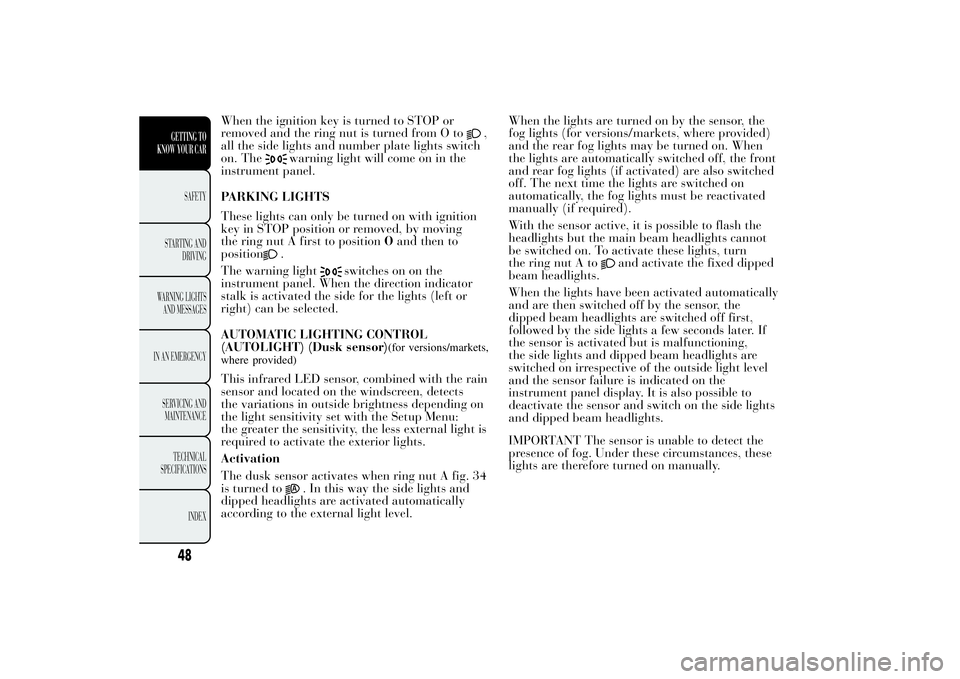
When the ignition key is turned to STOP or
removed and the ring nut is turned from O to
,
all the side lights and number plate lights switch
on. The
warning light will come on in the
instrument panel.
PARKING LIGHTS
These lights can only be turned on with ignition
key in STOP position or removed, by moving
the ring nut A first to positionOand then to
position.
The warning light
switches on on the
instrument panel. When the direction indicator
stalk is activated the side for the lights (left or
right) can be selected.
AUTOMATIC LIGHTING CONTROL
(AUTOLIGHT) (Dusk sensor)
(for versions/markets,
where provided)
This infrared LED sensor, combined with the rain
sensor and located on the windscreen, detects
the variations in outside brightness depending on
the light sensitivity set with the Setup Menu:
the greater the sensitivity, the less external light is
required to activate the exterior lights.
Activation
The dusk sensor activates when ring nut A fig. 34
is turned to
. In this way the side lights and
dipped headlights are activated automatically
according to the external light level.When the lights are turned on by the sensor, the
fog lights (for versions/markets, where provided)
and the rear fog lights may be turned on. When
the lights are automatically switched off, the front
and rear fog lights (if activated) are also switched
off. The next time the lights are switched on
automatically, the fog lights must be reactivated
manually (if required).
With the sensor active, it is possible to flash the
headlights but the main beam headlights cannot
be switched on. To activate these lights, turn
the ring nut A to
and activate the fixed dipped
beam headlights.
When the lights have been activated automatically
and are then switched off by the sensor, the
dipped beam headlights are switched off first,
followed by the side lights a few seconds later. If
the sensor is activated but is malfunctioning,
the side lights and dipped beam headlights are
switched on irrespective of the outside light level
and the sensor failure is indicated on the
instrument panel display. It is also possible to
deactivate the sensor and switch on the side lights
and dipped beam headlights.
IMPORTANT The sensor is unable to detect the
presence of fog. Under these circumstances, these
lights are therefore turned on manually.
48GETTING TO
KNOW YOUR CAR
SAFETY
STARTING
AND
DRIVING
WARNING LIGHTS
AND MESSAGES
IN AN EMERGENCY
SERVICING AND
MAINTENANCE
TECHNICAL
SPECIFICATIONS
INDEX
Page 57 of 299
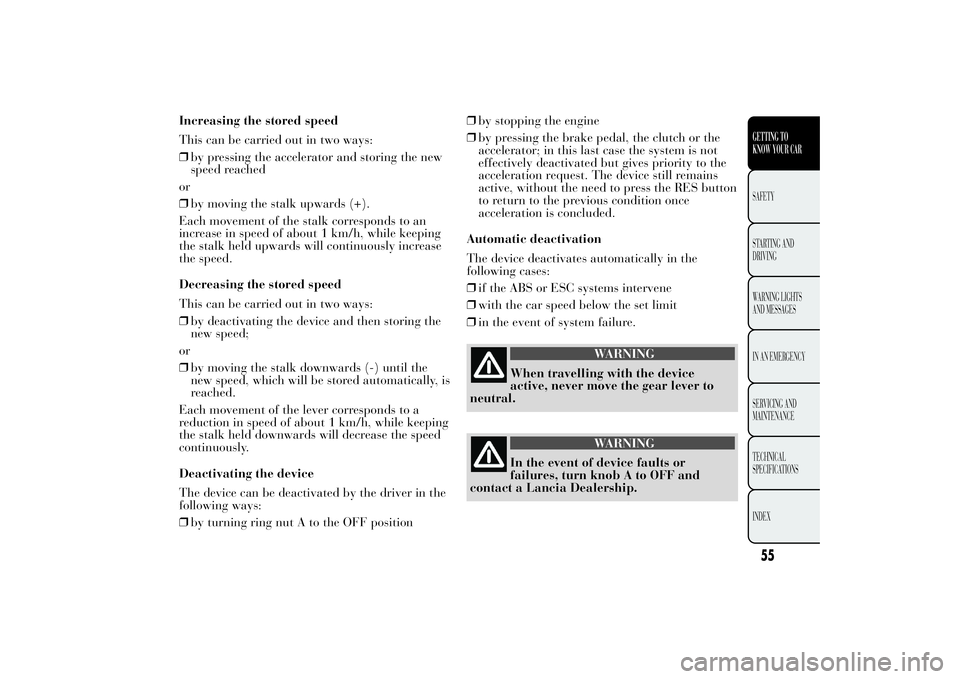
Increasing the stored speed
This can be carried out in two ways:
❒by pressing the accelerator and storing the new
speed reached
or
❒by moving the stalk upwards (+).
Each movement of the stalk corresponds to an
increase in speed of about 1 km/h, while keeping
the stalk held upwards will continuously increase
the speed.
Decreasing the stored speed
This can be carried out in two ways:
❒by deactivating the device and then storing the
new speed;
or
❒by moving the stalk downwards (-) until the
new speed, which will be stored automatically, is
reached.
Each movement of the lever corresponds to a
reduction in speed of about 1 km/h, while keeping
the stalk held downwards will decrease the speed
continuously.
Deactivating the device
The device can be deactivated by the driver in the
following ways:
❒by turning ring nut A to the OFF position❒by stopping the engine
❒by pressing the brake pedal, the clutch or the
accelerator; in this last case the system is not
effectively deactivated but gives priority to the
acceleration request. The device still remains
active, without the need to press the RES button
to return to the previous condition once
acceleration is concluded.
Automatic deactivation
The device deactivates automatically in the
following cases:
❒if the ABS or ESC systems intervene
❒with the car speed below the set limit
❒in the event of system failure.
WARNING
When travelling with the device
active, never move
the gear lever to
neutral.
WARNING
In the event of device faults or
failures, turn knob
A to OFF and
contact a Lancia Dealership.
55GETTING TO
KNOW YOUR CARSAFETY
STARTING
AND
DRIVING
WARNING LIGHTS
AND MESSAGES
IN AN EMERGENCY
SERVICING AND
MAINTENANCE
TECHNICAL
SPECIFICATIONS
INDEX
Page 62 of 299

CENTRAL LOCKING
Press button
fig. 45 to lock all the doors
simultaneously (the LED on the button will light
up when the doors are locked). Locking takes
place irrespective of the position of the ignition
key.
DUALDRIVE ELECTRIC POWER STEERING
(for versions/markets, where provided)
Press the CITY button fig. 46 to activate the
function (see paragraph "Dualdrive electric power
steering" in this chapter). When this function is
active, the word CITY on the instrument panel
will light up. To deactivate the function press the
button again.ECO FUNCTION
(for versions/markets, where provided)
Press the ECO button fig. 47 for at least 5 seconds
to activate the function.
When the ECO function is activated, the car is set
for city driving, characterised by less effort on
the steering wheel (Dualdrive system on) and
reduced fuel consumption. When this function is
activated, the word ECO on the display will light
up on some versions.
This function stays in the memory and, when the
vehicle is started again, the system keeps the
setting it had before the engine was stopped. Press
the ECO button again to deactivate the function
and restore the normal driving setting.
fig. 45
L0F0081
fig. 46
L0F0043
60GETTING TO
KNOW YOUR CAR
SAFETY
STARTING
AND
DRIVING
WARNING LIGHTS
AND MESSAGES
IN AN EMERGENCY
SERVICING AND
MAINTENANCE
TECHNICAL
SPECIFICATIONS
INDEX
Page 84 of 299
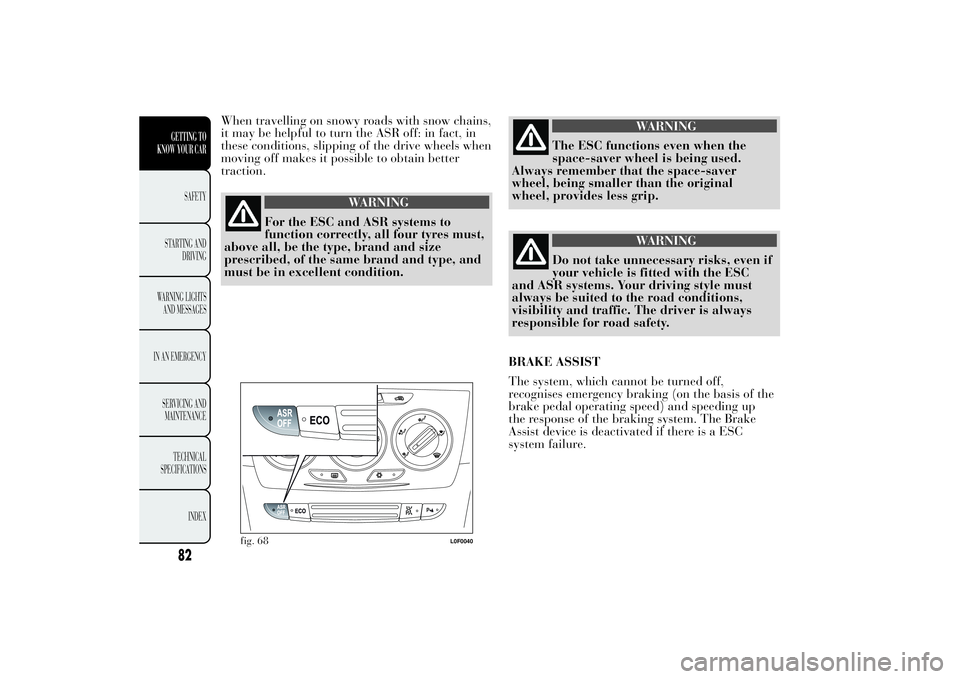
When travelling on snowy roads with snow chains,
it may be helpful to turn the ASR off: in fact, in
these conditions, slipping of the drive wheels when
moving off makes it possible to obtain better
traction.
WARNING
For the ESC and ASR systems to
function correctly,
all four tyres must,
above all, be the type, brand and size
prescribed, of the same brand and type, and
must be in excellent condition.
WARNING
The ESC functions even when the
space-saver wheel is
being used.
Always remember that the space-saver
wheel, being smaller than the original
wheel, provides less grip.
WARNING
Do not take unnecessary risks, even if
your vehicle is
fitted with the ESC
and ASR systems. Your driving style must
always be suited to the road conditions,
visibility and traffic. The driver is always
responsible for road safety.
BRAKE ASSIST
The system, which cannot be turned off,
recognises emergency braking (on the basis of the
brake pedal operating speed) and speeding up
the response of the braking system. The Brake
Assist device is deactivated if there is a ESC
system failure.
fig. 68
L0F0040
82GETTING TO
KNOW YOUR CAR
SAFETY
STARTING
AND
DRIVING
WARNING LIGHTS
AND MESSAGES
IN AN EMERGENCY
SERVICING AND
MAINTENANCE
TECHNICAL
SPECIFICATIONS
INDEX
Page 85 of 299

MSR SYSTEM
(Motor Schleppmoment Regelung)
This system is an integral part of the ABS, that
intervenes, if there is sudden downshifting,
restoring torque to the engine, thereby preventing
excessive drive at the drive wheels which,
especially in poor grip conditions, could lead to a
loss in stability of the car.
START&STOP SYSTEMINTRODUCTION
The Start&Stop system automatically stops the
engine each time the car is stationary and starts it
again when the driver wants to move off. In this
way, the car efficiency is increased, by reducing
consumption, dangerous gas emissions and noise
pollution.
The system activates every time the car is started.
OPERATING MODES
Engine stopping mode
With the car stopped, the engine stops with
gearbox in neutral and clutch pedal released.
NoteThe engine can only be stopped
automatically after driving at a speed of more
than about 10 km/h, to prevent the engine from
being repeatedly stopped when driving at walking
pace.
Symbol
appears on the display when the engine
stops.
83GETTING TO
KNOW YOUR CARSAFETY
STARTING
AND
DRIVING
WARNING LIGHTS
AND MESSAGES
IN AN EMERGENCY
SERVICING AND
MAINTENANCE
TECHNICAL
SPECIFICATIONS
INDEX
Page 86 of 299

Engine t mode
Press the clutch pedal to restart the engine.
MANUAL SYSTEM ACTIVATION/
DEACTIVATION
To activate/deactivate the system manually, press
the button
fig. 69 on the dashboard control
trim.
Start&Stop system activation
Start&Stop system activation is signalled by a
message on the display. In this condition, the LED
on the button
is off.
Start&Stop system deactivation
Versions with multifunction display: a message
appears on the display when the Start&Stop
system is deactivated.Versions with reconfigurable multifunction
display: the
symbol and a message appear on
the display when the Start&Stop system is
deactivated.
The LED above the
button is on when the
system is deactivated.
ENGINE STOPPING FAILURE CONDITIONS
When the system is active, due to comfort,
emission control and safety reasons, the engine
does not stop in some conditions, among which:
❒engine still cold;
❒especially cold outside temperature;
❒battery not sufficiently charged;
❒heated rear window activated;
❒windscreen wipers working at maximum speed;
❒particulate filter regeneration (DPF) in progress
(diesel engines only);
❒driver's door not shut;
❒driver's seat belt not fastened;
❒reverse gear engaged (for example, for parking
manoeuvres);
❒for versions equipped with automatic climate
control (for versions/markets, where provided),
if an adequate level of thermal comfort has
not been reached or with MAX-DEF activation;
❒during the first period of use, to initialise the
system.
fig. 69
L0F0044
84GETTING TO
KNOW YOUR CAR
SAFETY
STARTING
AND
DRIVING
WARNING LIGHTS
AND MESSAGES
IN AN EMERGENCY
SERVICING AND
MAINTENANCE
TECHNICAL
SPECIFICATIONS
INDEX
res arting
Page 94 of 299
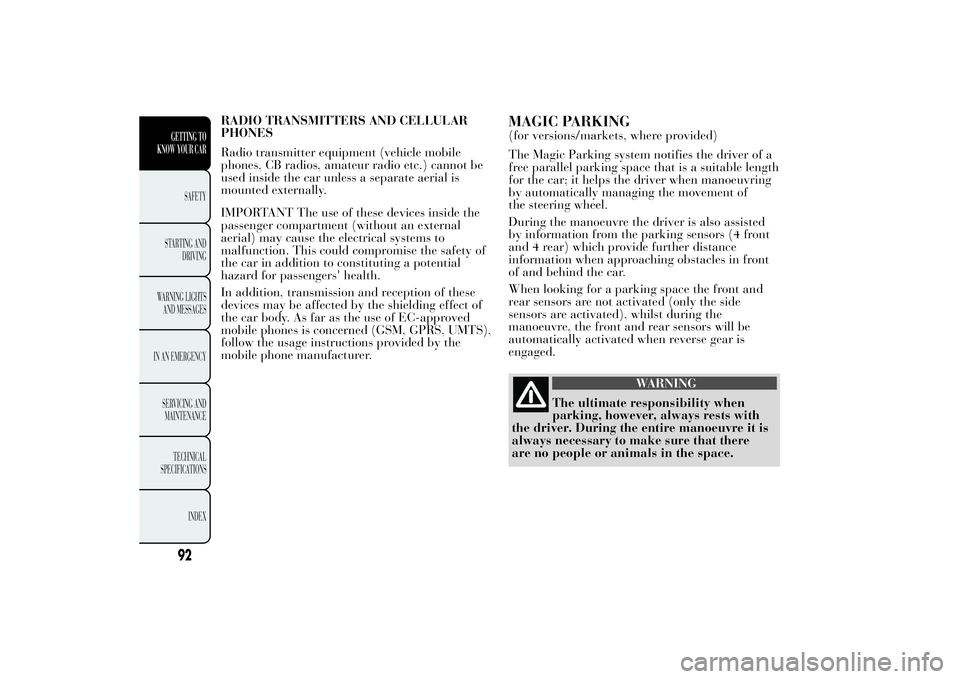
RADIO TRANSMITTERS AND CELLULAR
PHONES
Radio transmitter equipment (vehicle mobile
phones, CB radios, amateur radio etc.) cannot be
used inside the car unless a separate aerial is
mounted externally.
IMPORTANT The use of these devices inside the
passenger compartment (without an external
aerial) may cause the electrical systems to
malfunction. This could compromise the safety of
the car in addition to constituting a potential
hazard for passengers' health.
In addition, transmission and reception of these
devices may be affected by the shielding effect of
the car body. As far as the use of EC-approved
mobile phones is concerned (GSM, GPRS, UMTS),
follow the usage instructions provided by the
mobile phone manufacturer.
MAGIC PARKING(for versions/markets, where provided)
The Magic Parking system notifies the driver of a
free parallel parking space that is a suitable length
for the car; it helps the driver when manoeuvring
by automatically managing the movement of
the steering wheel.
During the manoeuvre the driver is also assisted
by information from the parking sensors (4 front
and 4 rear) which provide further distance
information when approaching obstacles in front
of and behind the car.
When looking for a parking space the front and
rear sensors are not activated (only the side
sensors are activated), whilst during the
manoeuvre, the front and rear sensors will be
automatically activated when reverse gear is
engaged.
WARNING
The ultimate responsibility when
parking, however,
always rests with
the driver. During the entire manoeuvre it is
always necessary to make sure that there
are no people or animals in the space.
92GETTING TO
KNOW YOUR CAR
SAFETY
STARTING
AND
DRIVING
WARNING LIGHTS
AND MESSAGES
IN AN EMERGENCY
SERVICING AND
MAINTENANCE
TECHNICAL
SPECIFICATIONS
INDEX
Page 95 of 299
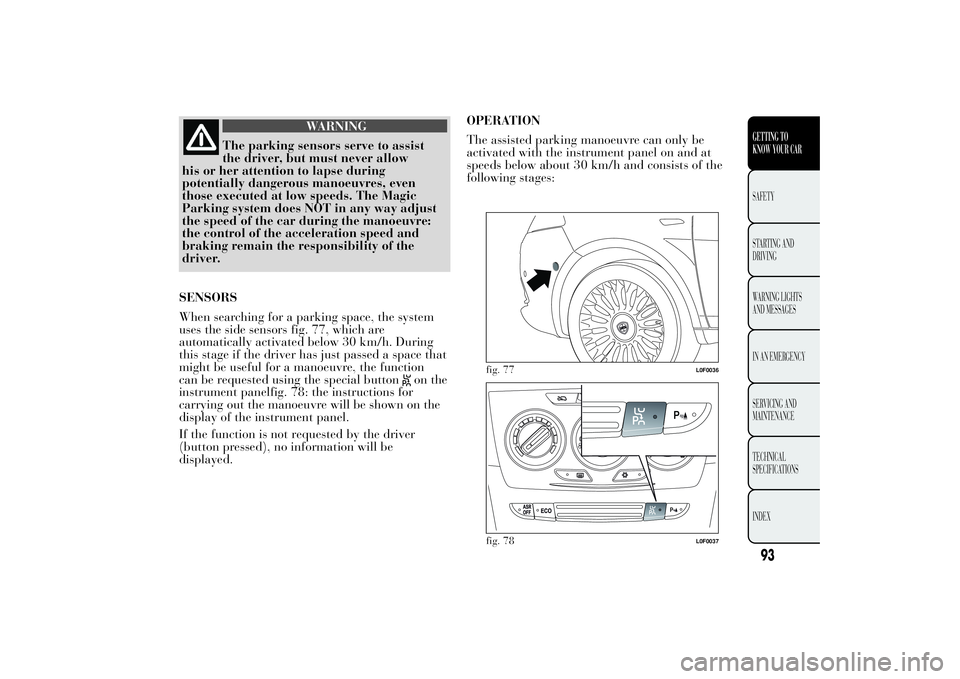
WARNING
The parking sensors serve to assist
the driver,
but must never allow
his or her attention to lapse during
potentially dangerous manoeuvres, even
those executed at low speeds. The Magic
Parking system does NOT in any way adjust
the speed of the car during the manoeuvre:
the control of the acceleration speed and
braking remain the responsibility of the
driver.
SENSORS
When searching for a parking space, the system
uses the side sensors fig. 77, which are
automatically activated below 30 km/h. During
this stage if the driver has just passed a space that
might be useful for a manoeuvre, the function
can be requested using the special button
on the
instrument panelfig. 78: the instructions for
carrying out the manoeuvre will be shown on the
display of the instrument panel.
If the function is not requested by the driver
(button pressed), no information will be
displayed.OPERATION
The assisted parking manoeuvre can only be
activated with the instrument panel on and at
speeds below about 30 km/h and consists of the
following stages:
fig. 77
L0F0036
fig. 78
L0F0037
93GETTING TO
KNOW YOUR CARSAFETY
STARTING
AND
DRIVING
WARNING LIGHTS
AND MESSAGES
IN AN EMERGENCY
SERVICING AND
MAINTENANCE
TECHNICAL
SPECIFICATIONS
INDEX